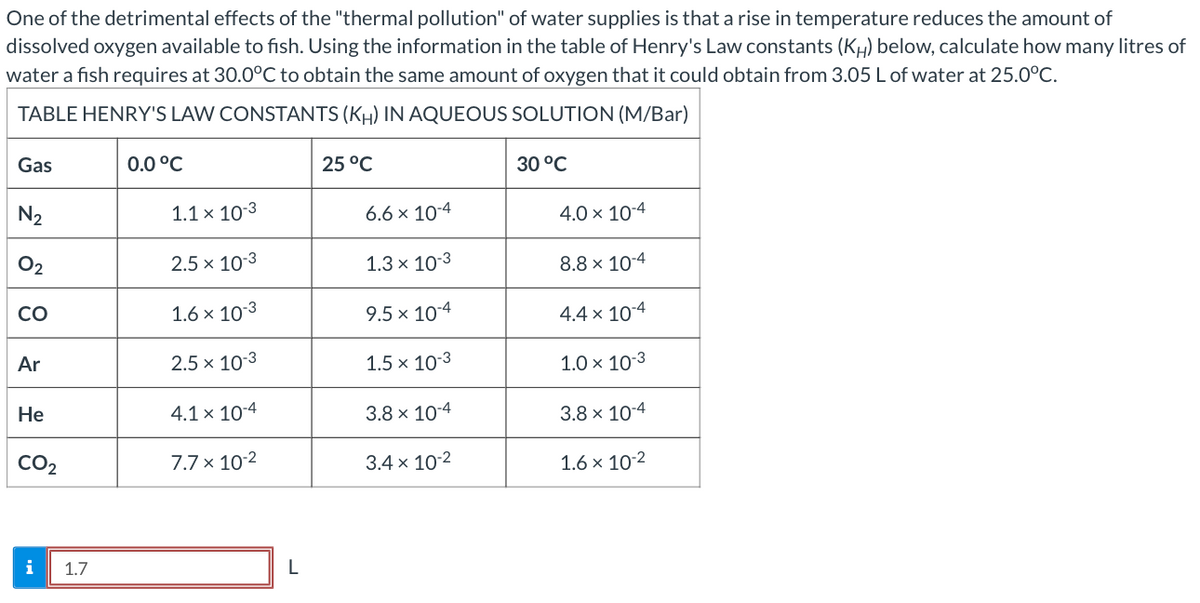One of the detrimental effects of the "thermal pollution" of water supplies is that a rise in temperature reduces the amount of dissolved oxygen available to fish. Using the information in the table of Henry's Law constants (K) below, calculate how many litres of water a fish requires at 30.0°C to obtain the same amount of oxygen that it could obtain from 3.05 L of water at 25.0°C. TABLE HENRY'S LAW CONSTANTS (KH) IN AQUEOUS SOLUTION (M/Bar) Gas 0.0 °C 25 °C 30 °C N2 1.1 x 10-3 6.6 x 10-4 4.0 x 10-4 O2 2.5 x 103 1.3 x 10-3 8.8 x 10-4 CO 1.6 x 103 9.5 x 104 4.4 x 10-4 Ar 2.5 x 10-3 1.5 x 10-3 1.0 x 10-3 Не 4.1 x 10-4 3.8 x 10-4 3.8 x 10-4 CO2 7.7 × 10-2 3.4 x 10-2 1.6 x 10-2 i 1.7
One of the detrimental effects of the "thermal pollution" of water supplies is that a rise in temperature reduces the amount of dissolved oxygen available to fish. Using the information in the table of Henry's Law constants (K) below, calculate how many litres of water a fish requires at 30.0°C to obtain the same amount of oxygen that it could obtain from 3.05 L of water at 25.0°C. TABLE HENRY'S LAW CONSTANTS (KH) IN AQUEOUS SOLUTION (M/Bar) Gas 0.0 °C 25 °C 30 °C N2 1.1 x 10-3 6.6 x 10-4 4.0 x 10-4 O2 2.5 x 103 1.3 x 10-3 8.8 x 10-4 CO 1.6 x 103 9.5 x 104 4.4 x 10-4 Ar 2.5 x 10-3 1.5 x 10-3 1.0 x 10-3 Не 4.1 x 10-4 3.8 x 10-4 3.8 x 10-4 CO2 7.7 × 10-2 3.4 x 10-2 1.6 x 10-2 i 1.7
Chemistry: Principles and Practice
3rd Edition
ISBN:9780534420123
Author:Daniel L. Reger, Scott R. Goode, David W. Ball, Edward Mercer
Publisher:Daniel L. Reger, Scott R. Goode, David W. Ball, Edward Mercer
Chapter12: Solutions
Section: Chapter Questions
Problem 12.52QE
Related questions
Question

Transcribed Image Text:One of the detrimental effects of the "thermal pollution" of water supplies is that a rise in temperature reduces the amount of
dissolved oxygen available to fish. Using the information in the table of Henry's Law constants (KH) below, calculate how many litres of
water a fish requires at 30.0°C to obtain the same amount of oxygen that it could obtain from 3.05 L of water at 25.0°C.
TABLE HENRY'S LAW CONSTANTS (KH) IN AQUEOUS SOLUTION (M/Bar)
Gas
0.0 °C
25 °C
30 °C
N2
1.1 x 10-3
6.6 × 10-4
4.0 × 10-4
O2
2.5 x 10-3
1.3 x 10-3
8.8 x 10-4
CO
1.6 x 103
9.5 x 104
4.4 x 10-4
Ar
2.5 x 10-3
1.5 x 10-3
1.0 x 10-3
Не
4.1 x 10-4
3.8 x 10-4
3.8 x 10-4
CO2
7.7 x 10-2
3.4 x 10-2
1.6 x 10-2
i
1.7
Expert Solution
This question has been solved!
Explore an expertly crafted, step-by-step solution for a thorough understanding of key concepts.
Step by step
Solved in 3 steps

Knowledge Booster
Learn more about
Need a deep-dive on the concept behind this application? Look no further. Learn more about this topic, chemistry and related others by exploring similar questions and additional content below.Recommended textbooks for you

Chemistry: Principles and Practice
Chemistry
ISBN:
9780534420123
Author:
Daniel L. Reger, Scott R. Goode, David W. Ball, Edward Mercer
Publisher:
Cengage Learning

Chemistry
Chemistry
ISBN:
9781305957404
Author:
Steven S. Zumdahl, Susan A. Zumdahl, Donald J. DeCoste
Publisher:
Cengage Learning


Chemistry: Principles and Practice
Chemistry
ISBN:
9780534420123
Author:
Daniel L. Reger, Scott R. Goode, David W. Ball, Edward Mercer
Publisher:
Cengage Learning

Chemistry
Chemistry
ISBN:
9781305957404
Author:
Steven S. Zumdahl, Susan A. Zumdahl, Donald J. DeCoste
Publisher:
Cengage Learning


Chemistry: An Atoms First Approach
Chemistry
ISBN:
9781305079243
Author:
Steven S. Zumdahl, Susan A. Zumdahl
Publisher:
Cengage Learning

Chemistry & Chemical Reactivity
Chemistry
ISBN:
9781133949640
Author:
John C. Kotz, Paul M. Treichel, John Townsend, David Treichel
Publisher:
Cengage Learning

General Chemistry - Standalone book (MindTap Cour…
Chemistry
ISBN:
9781305580343
Author:
Steven D. Gammon, Ebbing, Darrell Ebbing, Steven D., Darrell; Gammon, Darrell Ebbing; Steven D. Gammon, Darrell D.; Gammon, Ebbing; Steven D. Gammon; Darrell
Publisher:
Cengage Learning